Step by step analysis of how to raise geraniums what matters needing attention in the process of culture
Geranium, also known as hydrangea, stone red, into wax red, sunflower, sunflower, native to South Africa, is a perennial herbaceous flower. There is a long handle on the palm of the leaf, and the edge of the leaf is ringed with markings, and because its blooming flowers are dense like balls, it is also called Hydrangea. The flower colors of red, white, pink and purple vary a lot, and the flowering period starts from early winter to early summer. It can be potted indoors and outdoors and can be used as flowers in spring flower beds. So, how should geraniums be raised?
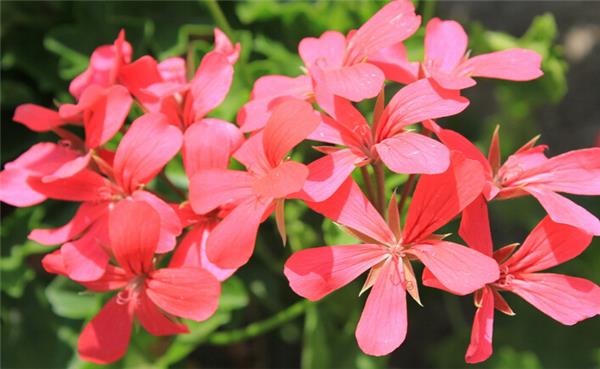
Culture methods of geraniums:
1. Soil: geranium is suitable for survival in sandy soil, basin soil can use rotten leaf soil mixed with appropriate amount of sand and rice chaff ash as soil, plus a small amount of bone powder. The pot should be changed once a year and the new culture soil should be replaced to facilitate growth and flowering.
2, moisture: geranium taboo watering too much, will cause root fester, watering frequency control in every three or two days watering on it, each watering to a large amount of water, watering thoroughly. You should not water too much in winter. You should see it dry and wet.
3. Light: the geranium needs plenty of sunlight during its growing period, so it must be placed in the sun in winter. Lack of light, long stems and leaves, soft pedicels, dysplastic inflorescences, buds often bloom poorly in low light and wither ahead of time.
Temperature: the most suitable temperature for geraniums is 10-20 degrees Celsius, that is, spring and autumn is the most suitable, too cold in winter and too hot in summer. So in the summer, we must prevent the sun exposure, should be placed in a cool place, in winter when the indoor temperature is not lower than 0 ℃.
5, fertilization: geraniums do not like big fertilizer, too much fertilizer will make geraniums grow too prosperous and not conducive to flowering. In order to bloom luxuriantly, watering dilute fertilizer water (rotten bean cake water) once every 1 to 2 weeks can promote normal flowering by watering 800 times potassium dihydrogen phosphate solution every 7 to 10 days.
6. pest control: geraniums are poorly ventilated and too humid, and are prone to leaf spot and Fusarium wilt. After discovery, pay attention to ventilation, immediately remove sick flowers and leaves to prevent infection, and spray the same amount of Bordeaux solution to prevent and cure. The main pests are red spiders and whitefly, which can be sprayed with 1000 times of omethoate emulsion.
7. Pruning: pruning in order to promote more flowering of the geranium with more branches, it is necessary to pick the heart of the plant many times to promote it to increase branches and budding. After shedding the flowers, cut off the residual flowers at the right time, cut off the too dense and thin branches, so as not to consume too much nutrients, but it is cold in winter and should not be re-cut.
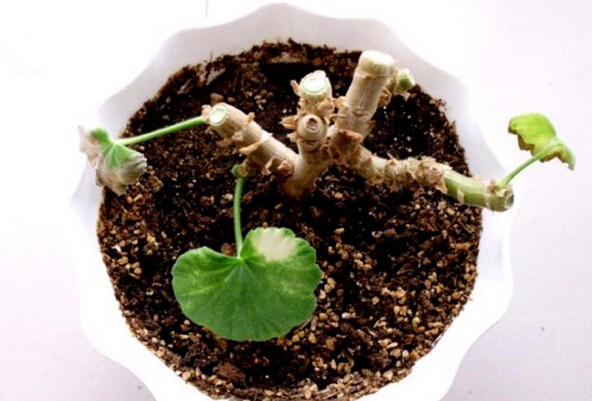
Geraniums prefer a warm, moist and sunny environment. Poor cold resistance, afraid of dampness and high temperature. The suitable temperature for growth is 13: 19 ℃ from March to September, and 10: 12 ℃ in winter. It is semi-dormant from June to July, so watering should be strictly controlled. Suitable for fertile, loose and well-drained sandy loam. The winter temperature is not lower than 10 ℃ and can withstand 5 ℃ low temperature in a short time. So, what matters should be paid attention to in the process of breeding?
Points for attention in geranium culture:
When breeding geraniums, we should pay attention to the prevention and control of pests, so as to avoid the unhealthy growth of their plants because of pests, and the exposure to sunlight, especially in summer. Water should also be properly watered, and do not pour too much water at once, so that it is possible to drown the plant.
High temperature, direct sunlight and stagnant water in the basin after rain will affect the dormancy of geraniums and even the death of rotten roots. Therefore, the dormant period should be put on the shady balcony, windowsill, or the courtyard to avoid the light and not be drenched by rain.
Pelargonium has a long flowering period, strong adaptability to the environment, plant size suitable for family potted plants, easy to reproduce, very popular, is one of the common potted flowers in families, and is also a common flower in flower beds in warm areas in winter. The small flowers of geranium are reunited, and the large inflorescences are shaped like hydrangeas with bright colors. So, what is the classification of geraniums?
Horseshoe geranium: plant height 30-HO rice. It gets its name because of the obvious dark brown horseshoe pattern in its leaf edge. The petals are of the same color, dark red to white, the upper two petals are very short, and the petals are narrowly wedge-shaped. This species produces many varieties of colored leaves.
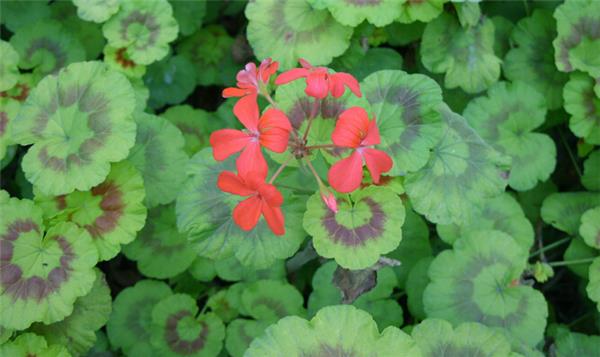
Home geranium: also known as butterfly geranium, foreign butterfly. The whole plant has soft hairs. There are no hoof lines on the leaves, and the teeth of the leaf margin are sharp and irregular. The flowers are large, with white, light red, lavender and other colors. It gets its name because of two red or purple patches on its petals.
Pelargonium: also known as Fujimoto geranium, Ivy leaf pelargonium. The stem is semi-trailing, and the plant is ten-day or scandent. Leaves peltate, slightly glossy. The flowers are small, 4-8 flowers gather, and the flowers are white, pink, red, purple and pink. Flowering in winter and spring.
Aromatic geranium: also known as scented geranium, round-leaf geranium. The stem is thin and weak, and the new branches and leaves are often clustered at the top of the stem. Umbels, flowers small, white, upper two petals with red-purple markings. Touch the leaves with your hands. That is, emit an attractive fragrance.
Fragrant leaf geranium: also known as touch incense. Semi-shrub. Leaves palmate, 5-7-parted, lobes pinnately lobed again. The flowers are pink or light red, with purplish red markings in the center, and the upper two petals are larger. Flowering in summer.
Chrysanthemum leaf pelargonium: stems with long hairs. The leaves are palmately parted, and the lobes are subdivided into linear shapes. The whole plant is covered with white powder. The flowers are rose-red with purple spots and stripes. Flowering in summer.
Geraniums are native to southern Africa and are widely cultivated all over the world. Young plants are fleshy herbs and old plants are semi-lignified; flowers that decorate windowsills are good in the West, especially in continental Europe, such as Germany, Austria and other countries. So, what is the role of geraniums and the method of reproduction?
The role of geraniums
Psychological effect
Geraniums are a tonic for the nervous system that soothes anxiety, depression and boosts mood. Restore mental balance, and because it can also affect the adrenal cortex, it relieves stress.
Physiological effect
Pelargonium essential oil has the functions of stimulating the lymphatic system and diuresis, which can enhance each other to help the body remove excessive body fluids quickly and effectively. Can be used to treat cellulitis, humoral retardation and ankle edema; can help liver and kidney detoxification; can treat jaundice, kidney stones and a variety of urethral infections; can also help many women reduce premenstrual fluid retention symptoms.
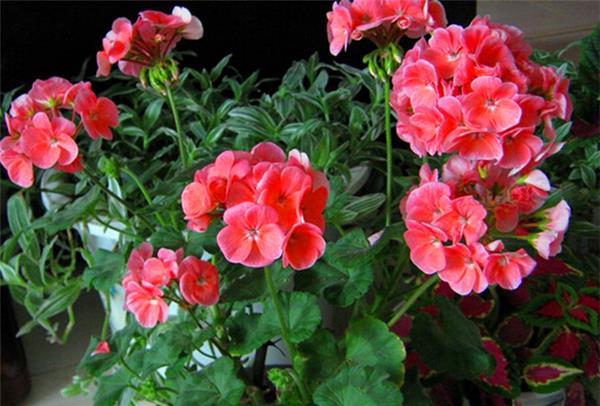
Cosmetic value
Geraniums are suitable for all kinds of skin conditions because they balance sebum secretion and make the skin full. May be good for eczema, burns, herpes zoster, herpes, ringworm and frostbite. It is also good for loose, blocked pores and oily skin. It can be called a comprehensive skin cleanser. As the geranium can promote blood circulation, it will make the pale skin more ruddy and energetic after use. Used in incense fumigator or topdressing with towels can stimulate the lymphatic system and strengthen the circulatory system.
Propagation methods of geraniums
Sowing and reproduction
It can be carried out in spring and autumn, and indoor pot sowing in spring is better. The optimum temperature for germination is 20-25 ℃. The geranium seed is not large, and the soil cover should not be deep after sowing, and it will germinate in about 2-5 days. It will sow in autumn and blossom in the summer of the following year. After sowing and propagation, excellent intermediate varieties can be selected and bred.
Cuttage propagation
All the plants can be planted except that the plants are semi-dormant from June to July. It is better to use spring and autumn. High temperature in summer, cuttings are easy to blacken and rot. The cuttings are 10 cm long, and the top part is the best, with vigorous growth and fast rooting. After cutting the cuttings, let the cut dry for several days, form a thin film, and then insert it into the sand bed or the mixed matrix of expanded perlite and peat, be careful not to hurt the bark of the cuttings, otherwise the wound will rot easily. After insertion, put it in a semi-shaded place and keep it at room temperature for 13-18 ℃. It will take root after 14-21 days. When the root length is 3-4 cm, it can be potted. Soaking the base of cuttings with 0.01% indolebutyric acid for 2 seconds can improve the survival rate and rooting rate of cuttings. Generally, the cuttings blossom in 6 months, that is, in January, in June, in October, and in February to March of the following year.
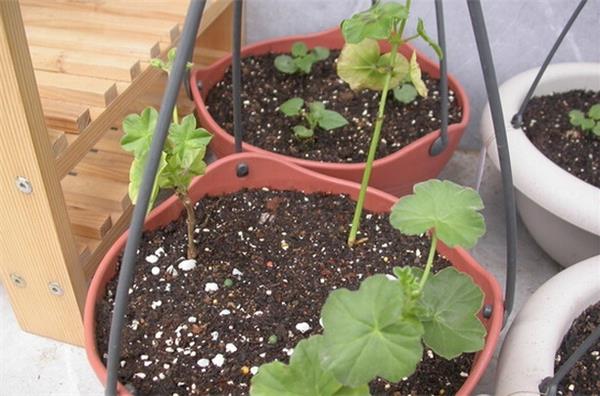
Greenhouse propagation
The geranium has strong adaptability, bright color and long flowering period. it is suitable for indoor display, flower bed layout and so on. The greenhouse breeding technology is introduced as follows.
Tissue culture
Geraniums can also be propagated by tissue culture. Using MS medium as the basic medium, 0.001% indole acetic acid and kinetin were added to promote callus and adventitious buds, and 0.01% indole acetic acid was used to promote rooting. The method of tissue culture provides a new way for the breeding of improved varieties and superposition of new varieties of geranium.
The above is the information about how to raise geraniums and matters needing attention, how to reproduce and function, and so on. I hope you can understand geraniums better.
Lobes pinnately lobed again. The flowers are pink or light red, with purplish red markings in the center, and the upper two petals are larger. Flowering in summer.
Chrysanthemum leaf pelargonium: stems with long hairs. The leaves are palmately parted, and the lobes are subdivided into linear shapes. The whole plant is covered with white powder. The flowers are rose-red with purple spots and stripes. Flowering in summer.
Geraniums are native to southern Africa and are widely cultivated all over the world. Young plants are fleshy herbs and old plants are semi-lignified; flowers that decorate windowsills are good in the West, especially in continental Europe, such as Germany, Austria and other countries. So, what is the role of geraniums and the method of reproduction?
The role of geraniums
Psychological effect
Geraniums are a tonic for the nervous system that soothes anxiety, depression and boosts mood. Restore mental balance, and because it can also affect the adrenal cortex, it relieves stress.
Physiological effect
Pelargonium essential oil has the functions of stimulating the lymphatic system and diuresis, which can enhance each other to help the body remove excessive body fluids quickly and effectively. Can be used to treat cellulitis, humoral retardation and ankle edema; can help liver and kidney detoxification; can treat jaundice, kidney stones and a variety of urethral infections; can also help many women reduce premenstrual fluid retention symptoms.

Cosmetic value
Geraniums are suitable for all kinds of skin conditions because they balance sebum secretion and make the skin full. May be good for eczema, burns, herpes zoster, herpes, ringworm and frostbite. It is also good for loose, blocked pores and oily skin. It can be called a comprehensive skin cleanser. As the geranium can promote blood circulation, it will make the pale skin more ruddy and energetic after use. Used in incense fumigator or topdressing with towels can stimulate the lymphatic system and strengthen the circulatory system.
Propagation methods of geraniums
Sowing and reproduction
It can be carried out in spring and autumn, and indoor pot sowing in spring is better. The optimum temperature for germination is 20-25 ℃. The geranium seed is not large, and the soil cover should not be deep after sowing, and it will germinate in about 2-5 days. It will sow in autumn and blossom in the summer of the following year. After sowing and propagation, excellent intermediate varieties can be selected and bred.
Cuttage propagation
All the plants can be planted except that the plants are semi-dormant from June to July. It is better to use spring and autumn. High temperature in summer, cuttings are easy to blacken and rot. The cuttings are 10 cm long, and the top part is the best, with vigorous growth and fast rooting. After cutting the cuttings, let the cut dry for several days, form a thin film, and then insert it into the sand bed or the mixed matrix of expanded perlite and peat, be careful not to hurt the bark of the cuttings, otherwise the wound will rot easily. After insertion, put it in a semi-shaded place and keep it at room temperature for 13-18 ℃. It will take root after 14-21 days. When the root length is 3-4 cm, it can be potted. Soaking the base of cuttings with 0.01% indolebutyric acid for 2 seconds can improve the survival rate and rooting rate of cuttings. Generally, the cuttings blossom in 6 months, that is, in January, in June, in October, and in February to March of the following year.

Greenhouse propagation
The geranium has strong adaptability, bright color and long flowering period. it is suitable for indoor display, flower bed layout and so on. The greenhouse breeding technology is introduced as follows.
Tissue culture
Geraniums can also be propagated by tissue culture. Using MS medium as the basic medium, 0.001% indole acetic acid and kinetin were added to promote callus and adventitious buds, and 0.01% indole acetic acid was used to promote rooting. The method of tissue culture provides a new way for the breeding of improved varieties and superposition of new varieties of geranium.
The above is the information about how to raise geraniums and matters needing attention, how to reproduce and function, and so on. I hope you can understand geraniums better.
- Prev

A few simple steps to learn how to raise copper grass and what role it has
A few simple steps to learn how to raise copper grass and what role it has
- Next

Analysis of how to raise the golden tiger cactus and how to easily master the maintenance method
Analysis of how to raise the golden tiger cactus and how to easily master the maintenance method
Related
- Wuhan Hospital Iron Tree Blooming Result Was Instantly Frightened by the Gardener Master
- Which variety of camellia is the most fragrant and best? Which one do you like best?
- What is the small blue coat, the breeding methods and matters needing attention of the succulent plant
- Dormancy time and maintenance management of succulent plants during dormancy
- Minas succulent how to raise, Minas succulent plant pictures
- What are the varieties of winter succulent plants
- How to raise succulent plants in twelve rolls? let's take a look at some experience of breeding twelve rolls.
- Attention should be paid to water control for succulent plants during dormant period (winter and summer)
- Watering experience of twelve rolls of succulent plants
- Techniques for fertilizing succulent plants. An article will let you know how to fertilize succulent plants.

